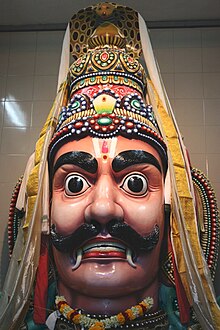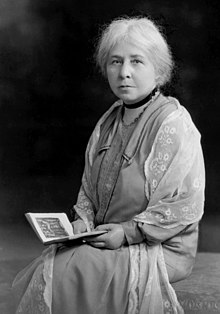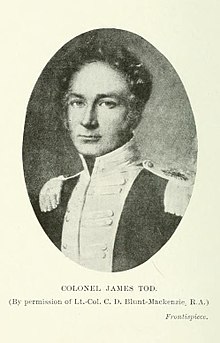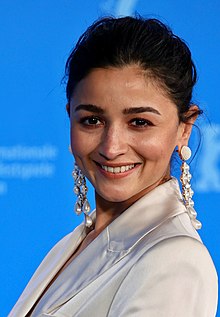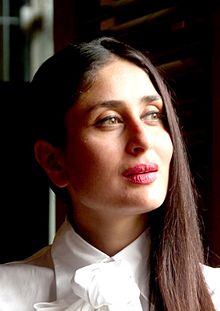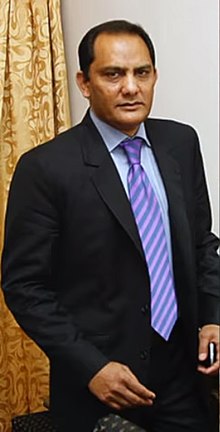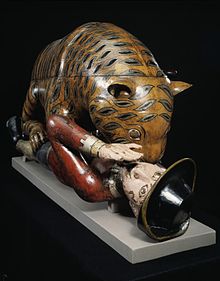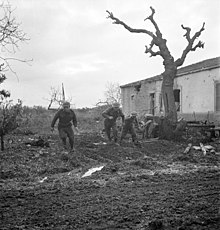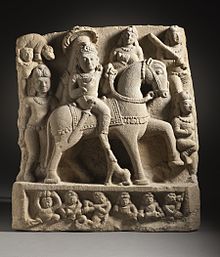Portal:India
Introduction

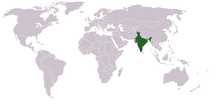
India, officially the Republic of India (ISO: Bhārat Gaṇarājya), is a country in South Asia. It is the seventh-largest country by area; the most populous country as of June 2023; and from the time of its independence in 1947, the world's most populous democracy. Bounded by the Indian Ocean on the south, the Arabian Sea on the southwest, and the Bay of Bengal on the southeast, it shares land borders with Pakistan to the west; China, Nepal, and Bhutan to the north; and Bangladesh and Myanmar to the east. In the Indian Ocean, India is in the vicinity of Sri Lanka and the Maldives; its Andaman and Nicobar Islands share a maritime border with Thailand, Myanmar, and Indonesia. (Full article...)
Selected pictures
Ujjal Dev Dosanjh, PC KC (/ˈuːdʒəl doʊˈsɑːndʒ/; Punjabi: ਉੱਜਲ ਦੇਵ ਦੁਸਾਂਝ; born September 9, 1947) is a Canadian lawyer and politician. He served as the 33rd premier of British Columbia from 2000 to 2001 and as a Liberal Party of Canada member of Parliament from 2004 to 2011. He was minister of health from 2004 until 2006, when the party lost government. He then served in the Official Opposition from January 2006 until 2011. Dosanjh was one of four visible minorities to serve in Paul Martin's Ministry.
Prior to being involved in federal politics, he spent ten years in provincial politics. He was elected in the Vancouver-Kensington riding in 1991 as a member of the British Columbia New Democratic Party (BC NDP) and re-elected there in 1996. He served as the Attorney General of British Columbia from August 1995 to February 2000. When the leader of his party resigned in 1999, Dosanjh put himself forward as a candidate and won the leadership vote. With the win he became Canada's first Indo-Canadian provincial leader. He served as the 33rd Premier of British Columbia until June 2001 when he lost the province's general election. He was the last NDP premier of the province until John Horgan was elevated to the position in 2017. (Full article...)
Anushka Sharma (pronounced [əˈnʊʃka ˈʃərma]; born 1 May 1988) is an Indian actress who works in Hindi films. She has received several awards, including a Filmfare Award. One of the highest-paid actresses in India as of 2018, she has appeared in Forbes India's Celebrity 100 since 2012 and was featured by Forbes Asia in their 30 Under 30 list of 2018.
Born in Ayodhya and raised in Bangalore, Sharma had her first modelling assignment for the fashion designer Wendell Rodricks in 2007 and later moved to Mumbai to pursue a full-time career as a model. She made her acting debut opposite Shah Rukh Khan in the top-grossing romantic film Rab Ne Bana Di Jodi (2008) and rose to prominence with starring roles in Yash Raj Films' romances Band Baaja Baaraat (2010) and Jab Tak Hai Jaan (2012); winning the Filmfare Award for Best Supporting Actress for the latter. Sharma went on to earn praise for playing strong-willed women in the crime thriller NH10 (2015), and the dramas Dil Dhadakne Do (2015), Ae Dil Hai Mushkil (2016), and Sui Dhaaga (2018). Her highest-grossing releases came with the sports drama Sultan (2016), and Rajkumar Hirani's films PK (2014) and Sanju (2018). This was followed by a hiatus from acting. (Full article...)

The Alchon Huns, (Bactrian: αλχον(ν)ο [Alkhon(n)o] or αλχαν(ν)ο [Alkhan(n)o]) also known as the Alkhan, Alchono, Alxon, Alkhon, Alakhana, and Walxon, were a nomadic people who established states in Central Asia and South Asia during the 4th and 6th centuries CE. They were first mentioned as being located in Paropamisus, and later expanded south-east, into the Punjab and Central India, as far as Eran and Kausambi. The Alchon invasion of the Indian subcontinent eradicated the Kidarite Huns who had preceded them by about a century, and contributed to the fall of the Gupta Empire, in a sense bringing an end to Classical India.
The invasion of India by the Huna peoples follows invasions of the subcontinent in the preceding centuries by the Yavana (Indo-Greeks), the Saka (Indo-Scythians), the Pahlava (Indo-Parthians), and the Kushana (Yuezhi). The Alchon Empire was the second of four major Huna states established in Central and South Asia. The Alchon were preceded by the Kidarites and succeeded by the Hephthalites in Bactria and the Nezak Huns in the Hindu Kush. The names of the Alchon kings are known from their extensive coinage, Buddhist accounts, and a number of commemorative inscriptions throughout the Indian subcontinent. (Full article...)
The Moro River campaign was an important battle of the Italian campaign during the Second World War, fought between elements of the British Eighth Army and LXXVI Panzer Corps (LXXVI Panzerkorps) of the German 10th Army (10. Armee). Lasting from 4 December 1943 to 4 January 1944, the campaign occurred primarily in the vicinity of the Moro River in eastern Italy. The campaign was designed as part of an offensive launched by General Sir Harold Alexander's Allied 15th Army Group, with the intention of breaching the German Army's Winter Line defensive system and advancing to Pescara—and eventually Rome.
Beginning on 4 December, four infantry divisions—one British, one Canadian, one Indian and one New Zealand (which included an armoured brigade)—and two armoured brigades (one British and one Canadian) of V Corps and XIII Corps attacked heavily defended German positions along the Moro River, achieving several exploitable bridgeheads by 8 December. Throughout the next week, nearly continuous combat operations by both sides—designed to keep one another pinned down—created stagnated defensive positions near Orsogna and a narrow pit known as "The Gully". After being held at the Gully for 10 days, the Canadians succeeded in outflanking German defences, and forcing a German withdrawal to the Ortona–Orsogna Line. On 20 December, the line was attacked by both corps. (Full article...)
Hampi or Hampe (Kannada: [hɐmpe]), also referred to as the Group of Monuments at Hampi, is a UNESCO World Heritage Site located in Hampi (City), Ballari district now Vijayanagara district, east-central Karnataka, India. Hampi predates the Vijayanagara Empire; it is mentioned in the Ramayana and the Puranas of Hinduism as Pampa Devi Tirtha Kshetra. Hampi continues as a religious centre, with the Virupaksha Temple, an active Adi Shankara-linked monastery and various monuments belonging to the old city.
Hampi was the capital of the Vijayanagara Empire from 1336 to 1565, when it was abandoned. It was a fortified city. Chronicles left by Persian and European travellers, particularly the Portuguese, say that Hampi was a prosperous, wealthy and grand city near the Tungabhadra River, with numerous temples, farms and trading markets. By 1500 CE, Hampi-Vijayanagara was the world's second-largest city, after Beijing, and probably India's richest at that time, attracting traders from Persia and Portugal. The Vijayanagara Empire was defeated by a coalition of Muslim sultanates; its capital was conquered, pillaged and destroyed by Sultanate armies in 1565, after which Hampi remained in ruins. (Full article...)
Buddhaghosa was a 5th-century Indian Theravada Buddhist commentator, translator and philosopher. He worked in the Great Monastery (Mahāvihāra) at Anurādhapura, Sri Lanka and saw himself as being part of the Vibhajjavāda school and in the lineage of the Sinhalese Mahāvihāra.
His best-known work is the Visuddhimagga ("Path of Purification"), a comprehensive summary of older Sinhala commentaries on Theravada teachings and practices. According to Sarah Shaw, in Theravada this systematic work is "the principal text on the subject of meditation." The interpretations provided by Buddhaghosa have generally constituted the orthodox understanding of Theravada scriptures since at least the 12th century CE. (Full article...)
Kashyap initially wanted to make a period film about Raman Raghav, but after the commercial failure of Bombay Velvet (2015), his previous film that was also set in the 1960s, he realized that he would be unable to find financing. Abandoning the period-piece concept, he co-wrote the film with Vasan Bala, setting it in the contemporary time. The film's music was composed by Ram Sampath, and Varun Grover wrote the lyrics. Jay Oza served as the film's cinematographer and Aarti Bajaj as its editor. (Full article...)

Russell's viper (Daboia russelii) is a highly venomous snake in the family Viperidae native to the Indian subcontinent and one of the big four snakes in India. It was described in 1797 by George Shaw and Frederick Polydore Nodder, and named after Patrick Russell, who wrote about it in his 1796 work An account of Indian serpents, collected on the coast of Coromandel. (Full article...)

Multiple tribes in the state of Meghalaya in northeast India practise matrilineal descent. Often referred to as Khasi people and Garo people, among the Khasi people which is a term used as a blanket term for various subgroups in Meghalaya who have distinguishing languages, rites, ceremonies, and habits, but share an ethnic identity as Ki Hynniew Trep (The Seven Huts) whereas the Garo people refers to the various groups of Achik people. The Khasi, Garo, and other subgroups have a proud heritage, including matrilineality, although it was reported in 2004 that they were losing some of their matrilineal traits. The tribes are said to belong to one of the "largest surviving matrilineal culture[s]" in the world. (Full article...)
The fourth disc of Collaborations is a DVD containing previously unissued film of a performance by the Music Festival from India, recorded at London's Royal Albert Hall in September 1974. Filmed by director Stuart Cooper, the footage required substantial restoration for its 2010 release. An audio-only track on the DVD, prepared by Anoushka Shankar and Paul Hicks, provides a more complete record of the concert. (Full article...)
The film marked Prasad's return to film production after an eight-year hiatus. P. G. Vinda was the film's director of photography. Mani Sharma composed the soundtrack and score; Marthand K. Venkatesh edited the film. Principal photography commenced in November 2015 and lasted until April 2016. Except for a schedule in Kodaikanal, the majority of the film's portions were shot in and around Hyderabad. (Full article...)
Revanta or Raivata (Sanskrit: रेवन्त, lit. "brilliant") is a minor Hindu deity. According to the Rig-Veda, Revanta is the youngest son of the sun-god Surya, and his wife Saranyu.
Revanta is chief of the Guhyakas, supernatural beings – like the Yakshas – who are believed to live as forest dwellers in the Himalayas. (Full article...)
Filmed in India, Mauritius and Scotland, this was Johar's directorial debut. One of his goals for the film was to set a new level for style in Hindi cinema. The music was composed by Jatin–Lalit, which was the biggest seller of the year. Kuch Kuch Hota Hai was released on 16 October 1998, worldwide and received positive reviews from critics who praised the setting, music, direction, cinematography, screenplay, performances and overall presentation. The film was successful in India and abroad, becoming the highest-grossing Indian film of the year and the third highest-grossing Indian film at that time. Outside India, the film was the highest-grossing Hindi film ever until its record was broken by Karan Johar's next directorial, Kabhi Khushi Kabhie Gham... (2001). (Full article...)
Filming, although significantly delayed, began in August 2009 at Valluvar Kottam in Chennai, where an ancient township film set with temples, forts, a lake and palaces had been built. The film's producers encountered difficulties in making prompt payments to its crew that consisted of more than 1000 members during the filming in the forests of Pollachi. The filming then shifted to Guindy National Park in Chennai, with the battle sequences shot in Kerala and Karnataka. (Full article...)
Shankar conceived the film in mid-2003 during the post-production period of his previous film, Boys. He based the film on his own life experiences during his formative years when he was disturbed by what he saw around him, and his eventual displeasure with the society. Pre-production for Anniyan began in November 2003 and principal photography in March 2004. The making of the film, which included numerous production delays, took 14 months. The film was shot at Hyderabad, Thanjavur, Tindivanam and Chennai, and the song sequences were filmed in Mumbai, Malaysia, Amsterdam and Tenkasi. The film was notable for its recreation of the Tyagaraja Aradhana music festival and the extensive use of time slice photography in an action sequence. (Full article...)
The film revolves around Ajay Kumar (Babu), a police officer and son of ex-MLA Shankar Narayana (Raj), who awakes from coma, but his health remains perilous. To aid his recovery, Kumar masquerades as a Member of the Legislative Assembly fulfilling his father's ambition for him, while also hunting his father's foes. The film began production on 28 June 2010 at Hyderabad. Shooting began on 22 October 2010 in Turkey and lasted till mid-September 2011. The film was predominantly shot in Hyderabad, with portions shot in Mumbai, Gujarat, Istanbul, Dubai, and Switzerland. (Full article...)
Rohit Gurunath Sharma (born 30 April 1987) is an Indian international cricketer who currently captains the India national cricket team across all formats. He is a right-handed batsman. Considered one of the best batsmen of his generation and one of the greatest opening batters of all time, Sharma is known for his timing, elegance, six-hitting abilities and leadership skills. Sharma holds several batting records which famously include most sixes in international cricket, most double centuries in ODI cricket (3), most centuries at Cricket World Cups (7) and joint most hundreds in Twenty20 Internationals (5). Rohit Sharma is the first player to score 5 T20I centuries. He plays for Mumbai Indians in IPL and for Mumbai in domestic cricket.
Sharma formerly captained Mumbai Indians and the team has won 5 titles in 2013, 2015, 2017, 2019 and 2020 under his leadership, making him the most successful captain in IPL history, sharing this record with MS Dhoni (5 title wins in IPL). With India, Sharma was a member of the team that won the 2007 T20 World Cup, and the 2013 ICC Champions Trophy, where he played in the finals of both tournaments. Rohit is one of four players to have played in every edition of the ICC T20 World Cup, from the inaugural edition in 2007 to the latest one in 2022. (Full article...)
The killing was ordered by a khap panchayat (khap), a religious caste-based council among Jats, in their Karora village in Kaithal district, Haryana. The khap passed a decree prohibiting marriage against societal norms. Such caste-based councils are common in the inner regions of several Indian states, including Haryana, Punjab, western Uttar Pradesh and parts of Rajasthan, and have been operating with government approval for years. In any event, the state government expressed no concern about the ruling of the khap panchayat. (Full article...)
News
- 19 April 2024 – 2024 Indian general election
- Indians begin voting to elect members to the 18th Lok Sabha. There are 969 million people eligible to vote, and voting will continue until June in seven phases. (AP)
- 16 April 2024 – Naxalite–Maoist insurgency
- Indian security forces kill at least 29 Maoist insurgents in a major counterinsurgency operation in Kanker district, Chhattisgarh. A large quantity of weapons are also seized. (NDTV)
- 28 March 2024 – 2023–24 South-West Indian Ocean cyclone season
- Cyclone Gamane makes landfall in Madagascar, killing at least eleven people and causing widespread flooding, according to local officials. (AP)
- 12 March 2024 – Piracy off the coast of Somalia
- About 20 armed pirates hijack a Bangladeshi bulk carrier in the Indian Ocean that was en route to the United Arab Emirates. The vessel is under the control of the pirates and is heading towards the coast of Somalia. (The National News)
- 1 March 2024 –
- At least eight people are injured when a suspected homemade bomb explodes in a cafe in Bengaluru, Karnataka, India. (Reuters)
Did you know...
- ... that Abdul Ghani Azhari wrote Qadim Tarikh-e-Gujjar in Urdu, detailing the ancient history of Gujjars in India?
- ... that police in Indianola, Mississippi, shot an unarmed 11-year-old African-American boy after responding to his 9-1-1 call for help at his home?
- ... that Zakir Husain was the first Muslim and the first governor of a state to be elected President of India?
- ... that the 2017 short film Juice, starring Shefali Shah as a middle-class Indian wife defying patriarchal norms, won two Filmfare Short Film Awards?
- ... that in the 1932 baseball game in which pitcher Eddie Rommel won his last game, he pitched 17 innings in relief, an American League record?
- ... that George Vernon's loss against the Parsis cricket team was seen as "a blow to the prestige of the Empire"?
Timeline of Indian history, Indus Valley Civilisation, Dholavira, Science and technology in ancient India, Meluhha, Aryan invasion theory, Out of India theory, Greek conquests in India, Indian maritime history, Maurya Empire, Ashoka, Shunga Empire, Hoysala Empire, Vijayanagara, Satavahana dynasty, Indo-Greek Kingdom, Indo-Scythians, Indo-Parthian Kingdom, Kushan Empire, Western Satraps, Gupta Empire, Chola dynasty, Pala Empire, Islamic incursions in India, Mughal Empire, Maratha Empire, British Raj, East India Company, Governor-General, Viceroy, War of Independence, 1857, Indian independence movement, Indian National Army, Azad Hind, Quit India Movement, Partition of India, History of Republic of India, Non-Aligned Movement, Sino-Indian War, Indo-Pakistani War of 1947–1948, Indo-Pakistani War of 1965, Indo-Pakistani War of 1971, Kargil War, 2001–02 India–Pakistan standoff, Military, Demographic
Law, Hindu law, Constitution, Political parties (Indian National Congress, Bharatiya Janata Party), Foreign relations, Elections, Political divisions, Reservation in India
Government agencies, Legislative branch (Lok Sabha, Rajya Sabha) Executive branch (President & Vice President, Prime Minister & Deputy Prime Minister, Cabinet Ministers, Cabinet Secretary, Election Commission, Foreign Minister; Law enforcement: CBI, CID, Intelligence: IB, RAW), Directorate General of Income Tax Investigation Judicial branch (Supreme Court), Armed Forces (Army, Navy, Air Force, Border Security Force, Coast Guard)
Himalayas, Western Ghats, Eastern Ghats, Indo-Gangetic Plain, Deccan Plateau, Thar Desert, Ganges, Rann of Kutch, Brahmaputra River, Northeast India; Mountains, Valleys, Islands, Rivers; States and union territories, Cities, Districts, Regions, Fauna, Flora
Rupee, Bombay Stock Exchange, National Stock Exchange, Standard of living, Companies, Reserve Bank of India, Energy policy (Solar, Wind, Nuclear), Tourism, Transport (Expressways, Rail transport, Auto rickshaw),
Languages, Standard of living, Religion
Music (Carnatic, Hindustani, Indi-pop), Dance, Languages, Literature, Architecture, Film & TV, Cuisine, Holidays, Folklore, Education, Media, Indian martial arts
Indian Council of Agricultural Research (ICAR), Indian Institute of Astrophysics, National Centre for Software Technology, AIIMS, IISc, IIT, NIT, BITS-Pilani, INRegistry, Indian numbering system, Indian Space Research Organisation, National Internet Exchange of India, ICRISAT, International Institute of Information Technology, Hyderabad
Indian English, Indian nationality law, Numbering system, Indian Space Research Organisation, Telecommunications, National Highways Development Project, Flag, Vehicle registration plates, Indian nationalism, Metrication in India
Categories
Related portals
Religions in India
Indian Subcontinent
Other countries
Wikipedias in Indian languages
- অসমীয়া (Assamese)
- বাংলা (Bengali)
- भोजपुरी (Bhojpuri)
- বিষ্ণুপ্রিয়া মণিপুরী (Bishnupriya Manipuri)
- गोंयची कोंकणी / Gõychi Konknni (Konkani)
- ગુજરાતી (Gujarati)
- हिन्दी (Hindi)
- ಕನ್ನಡ (Kannada)
- कॉशुर/كشميري (Kashmiri)
- मैथिली (Maithili)
- മലയാളം (Malayalam)
- मराठी (Marathi)
- नेपाली (Nepali)
- नेपाल भाषा
- (Newari)
- ଓଡ଼ିଆ (Odiya)
- ਪੰਜਾਬੀ (Punjabi)
- पालि (Pali)
- संस्कृत (Sanskrit)
- ᱥᱟᱱᱛᱟᱲᱤ (Santali)
- سنڌي (Sindhi)
- தமிழ் (Tamil)
- తెలుగు (Telugu)
- ತುಳು (Tulu)
- اردو (Urdu)
Associated Wikimedia
The following Wikimedia Foundation sister projects provide more on this subject:
-
Commons
Free media repository -
Wikibooks
Free textbooks and manuals -
Wikidata
Free knowledge base -
Wikinews
Free-content news -
Wikiquote
Collection of quotations -
Wikisource
Free-content library -
Wikiversity
Free learning tools -
Wikivoyage
Free travel guide -
Wiktionary
Dictionary and thesaurus



